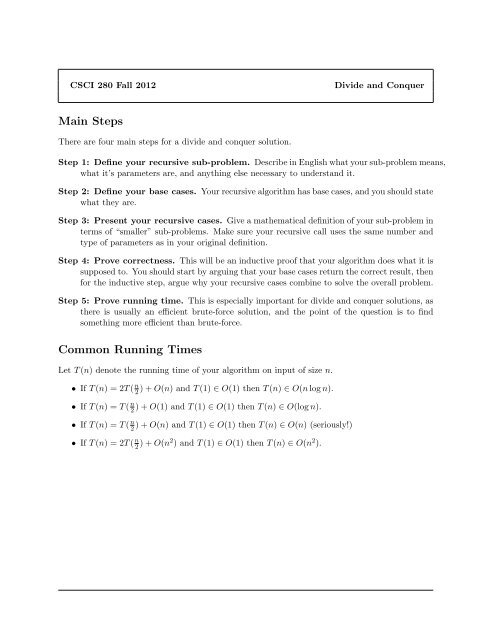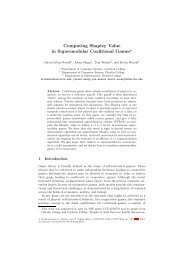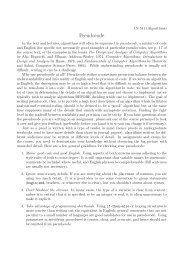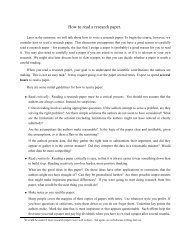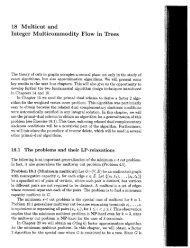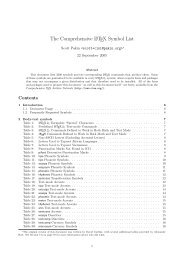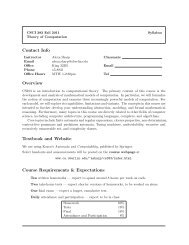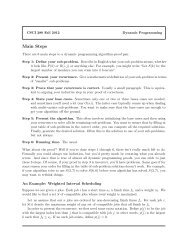You also want an ePaper? Increase the reach of your titles
YUMPU automatically turns print PDFs into web optimized ePapers that Google loves.
CSCI 280 Fall 2012<strong>Divide</strong> <strong>and</strong> <strong>Conquer</strong>Main StepsThere are four main steps for a divide <strong>and</strong> conquer solution.Step 1: Define your recursive sub-problem. Describe in English what your sub-problem means,what it’s parameters are, <strong>and</strong> anything else necessary to underst<strong>and</strong> it.Step 2: Define your base cases. Your recursive algorithm has base cases, <strong>and</strong> you should statewhat they are.Step 3: Present your recursive cases. Give a mathematical definition of your sub-problem interms of “smaller” sub-problems. Make sure your recursive call uses the same number <strong>and</strong>type of parameters as in your original definition.Step 4: Prove correctness. This will be an inductive proof that your algorithm does what it issupposed to. You should start by arguing that your base cases return the correct result, thenfor the inductive step, argue why your recursive cases combine to solve the overall problem.Step 5: Prove running time. This is especially important for divide <strong>and</strong> conquer solutions, asthere is usually an efficient brute-force solution, <strong>and</strong> the point of the question is to findsomething more efficient than brute-force.Common Running TimesLet T (n) denote the running time of your algorithm on input of size n.• If T (n) = 2T ( n 2) + O(n) <strong>and</strong> T (1) ∈ O(1) then T (n) ∈ O(n log n).• If T (n) = T ( n 2) + O(1) <strong>and</strong> T (1) ∈ O(1) then T (n) ∈ O(log n).• If T (n) = T ( n 2) + O(n) <strong>and</strong> T (1) ∈ O(1) then T (n) ∈ O(n) (seriously!)• If T (n) = 2T ( n 2 ) + O(n2 ) <strong>and</strong> T (1) ∈ O(1) then T (n) ∈ O(n 2 ).
Example: MergesortGiven a list L of n elements, let Mergesort(L) return the elements of L in non-decreasing sorted order.Then the following algorithm computes Mergesort(L) in O(n log n) time:Mergesort(L)if |L| = 1 thenreturn Lelsedivide L into two halves A <strong>and</strong> B of size ⌊ n 2 ⌋ <strong>and</strong> ⌈ n 2⌉, respectively.let A ∗ = Mergesort(A) <strong>and</strong> B ∗ = Mergesort(B)let L ∗ be a new empty listwhile both A ∗ <strong>and</strong> B ∗ are non-empty doif first element of A ∗ is smaller than first element of B ∗ thenappend the first element of A ∗ onto L ∗ <strong>and</strong> remove it from A ∗elseappend the first element of B ∗ onto L ∗ <strong>and</strong> remove it from B ∗end ifend whileif one of A ∗ or B ∗ is non-empty thenappend it to the end of L ∗end ifreturn L ∗end ifClaim. The algorithm runs in O(n log n) time.Proof. Let T (n) denote the running time of Mergesort(L) when L is a list of n elements. ThenT (n) = 2T (n/2) + O(n)T (1) = O(1)And therefore the running time is O(n log n).Claim. Mergesort(L) correctly returns the elements of L in non-decreasing sorted order.Proof. For a list L, let P (L) be the statement that Mergsort(L) correctly sorts L into nondecreasingorder. We will prove P (L) is true for any list L by strong induction on |L|.As a base case, consider when |L| = 1. This one-element list is already sorted, <strong>and</strong> ouralgorithm correctly returns L as the sorted list.For the induction hypothesis, suppose that P (L) is true for all lists of length < n; that is,suppose that for any list L of length < n, Mergesort(L) correctly sorts L.Now consider a list L of length n. Our algorithm divides L into two halves A <strong>and</strong> B of size < n;therefore, A ∗ <strong>and</strong> B ∗ are in sorted order by our induction hypothesis. The minimum element of Lis therefor either the minimum element of A ∗ (which is at the front of A ∗ ) or the minimum elementof B ∗ (which is at the front of B ∗ ). We correctly take whichever is smallest as the minimum ofL. We do this repeatedly, always selecting the next minimum element from the front of A ∗ or B ∗ ,until we’ve produced the sorted L.Therefore we have shown by induction that Mergesort(L) correctly sorts any list L.


